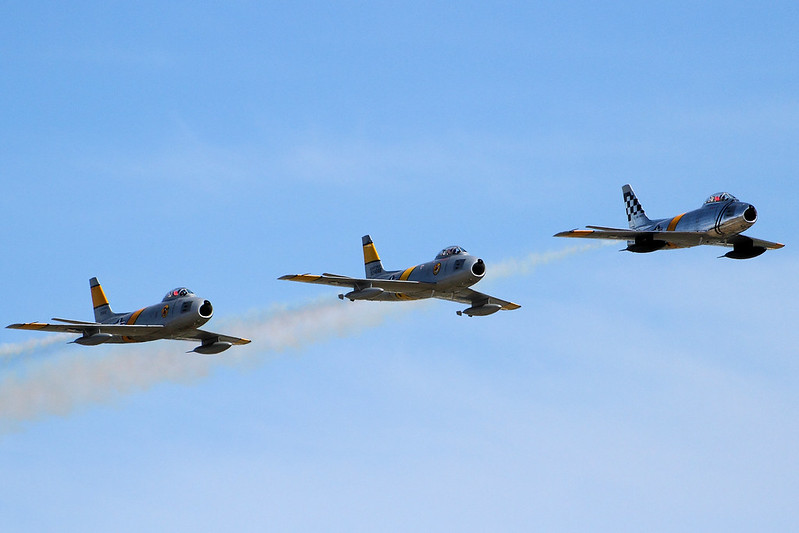F-86 Sabre
The counterpart of the MiG (15)
Source: Tim Felce
“F-86 Sabres – Chino Airshow 2014” by Airwolfhound is licensed under CC BY-SA 2.0
For some time after World War 2 have ended, the developments of jet aircrafts were kind of slow. Aside from the German Me-262 (who started the jet age in the first place), the British meteor, and some American designs (such as the P-80 Shooting Star and the FH-1 phantom). All of these designs were good, but they were considered outdated when the Soviet showed up with their MiG designs. Instantly Every other nations begins work like mad to make something that would capable of beating the new Soviet jet fighters. USA did it first, and come up with yet another legendary design, the F-86 sabre (although the design of the F-86 already begins in the middle of 1944).
History
The creations of the Sabre begins when North American Aviation (the same company that created the WW2 star the P-51 Mustang) got an order from the US Army Air Force (which would become a separate branch of its own and be know as the Air Force) in ( like what I said before) the middle of 1944. And the order was to produce a escort jet fighter/fighter-bomber that would be capable to work at high altitude and be controlled by 1 pilot. The North American did their magic and come up with 4 prototype designs by early 1945. The USAAF looked over them, and picked one of the prototype design called the XP-86. Although that prototype have some problem of flying at high speed. During that time the Germans have already find the benefits of using swept-wings and put it onto the Me-262. The Americans copy that and solved the XP-86’s speed problem. Finally, with some final touches here and there, the new aircraft, officially called F-86 Sabre, rolled off the production line on August 8th, 1947.
Stats
Length: 11.43 meters (37 feet and 1 inch)
Width: 11.27 meters (37 feet)
Height: 4.47 meters (15 feet and 5 inches)
Weight: 4987 kilograms (10,494 pounds) when fully loaded
Armaments: six 12.7mm Browning machine guns (or four 20mm cannons for later variants) and two 1000 pounds bombs or sixteen 5 inch rockets
Speed: 1086 km/h (675 mph)
Range: 1263 km (785 miles)
Engine: General Electric J47-GE-13 Turbojet engine
Combat Record
About 2 years after its production begins it officially joined service with the USAAF just in time for it to serve in the Korean War. Up until that point for most of the bombing missions the USAAF were still using WW2 aircrafts, such as the P-51 Mustang, and the bombers they were using is the B-29 Superfortress. Both of these(and more) types is still good to use, but they were no match against the MiG-15 that the North Koreans were using. But when the F-86 Sabre joined in, the tide changed. Instantly the F-86 were whipping the behind of the MiG-15 (literally, for many of the MiG killed by the Sabre were shot from the behind). Aside from the fact that the Sabre have better controls than the MiG-15, many of the pilots that flew the Sabre were already WW2 veterans and knows what they are doing, on the other hand many of the MiG-15 pilots (mostly Russians and Chinese) were only half (if at all) trained. Before the Sabre have arrived the MiG-15 have dominated an area called (by the NATO) the ‘MiG Alley’. Going there usually means suicides for most pilots, but that have changed with the arrival of the Sabre.
Aftermath
The Sabre had give a lengthy, and excellent, services to the US and to its allies and the countries who have bought it. But, eventually, the time for the Sabre had arrived. and the fighter was retired in 1980. However the F-86 that still remained were neither put into museums or ended up in private collections. They also lived on in games such as War Thunder and World of Warplanes.











